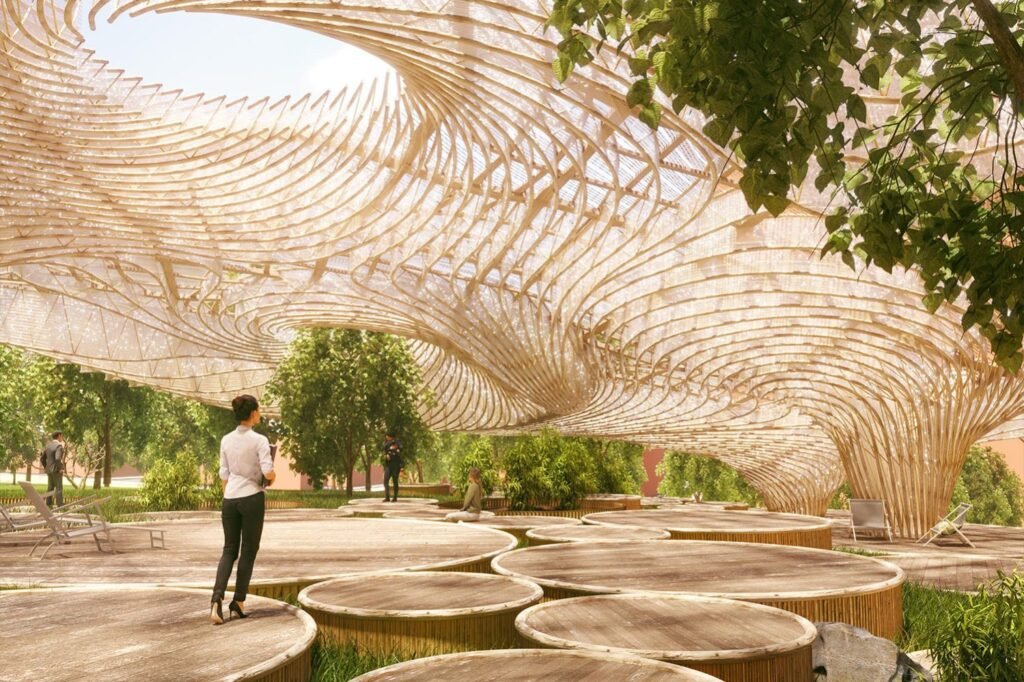Contemporary Architecture Trends: Sustainability, High-Tech, Parametric Design
Contemporary architecture in the 21st century is characterized by a diverse range of trends that respond to technological advancements, environmental concerns, and evolving societal needs. This article explores three prominent trends in contemporary architecture: sustainability, high-tech architecture, and parametric design.

Contemporary Architecture Trends
Sustainability in Architecture
Importance and Principles: Sustainability has become a central concern in contemporary architecture, driven by global awareness of climate change and the need for environmentally responsible design practices. Sustainable architecture aims to minimize negative environmental impact throughout a building’s lifecycle, from construction to operation and eventual demolition or reuse.
Key Principles Include:
- Energy Efficiency: Incorporating passive design strategies, renewable energy systems (such as solar panels and wind turbines), and energy-efficient building materials to reduce energy consumption and carbon emissions.
- Resource Efficiency: Using recycled materials, sustainable timber, and low-impact construction techniques to minimize resource depletion and waste generation.
- Biophilic Design: Integrating natural elements, green spaces, and natural lighting to improve indoor air quality, occupant well-being, and connection to nature.
Examples of Sustainable Architecture:
- One Central Park, Sydney: Designed by Jean Nouvel and PTW Architects, this residential complex features vertical gardens, solar panels, and rainwater harvesting systems that contribute to its self-sufficiency and environmental sustainability.
- The Edge, Amsterdam: Known as the world’s most sustainable building, The Edge incorporates advanced technologies such as smart sensors, energy-efficient LED lighting, and a climate ceiling system to optimize energy use and user comfort.
High-Tech Architecture
Origins and Characteristics: High-tech architecture, also known as Structural Expressionism, emerged in the late 20th century and continues to influence contemporary design with its emphasis on technological innovation, structural honesty, and aesthetic expression of technology.
Characteristics Include:
- Exposed Structures: Displaying structural elements such as steel frames, trusses, and mechanical systems as integral design features, celebrating their functional and aesthetic qualities.
- Integration of Technology: Incorporating advanced building systems, smart technologies, and digital fabrication techniques to enhance building performance, efficiency, and user experience.
- Futuristic Aesthetics: Embracing sleek, industrial aesthetics with clean lines, reflective surfaces, and a focus on precision engineering and machine-like forms.
Iconic Examples of High-Tech Architecture:
- The Gherkin (30 St Mary Axe), London: Designed by Norman Foster and Partners, The Gherkin exemplifies high-tech architecture with its distinctive cylindrical form, diagrid structural system, and energy-efficient design features.
- The Pompidou Centre, Paris: Designed by Renzo Piano and Richard Rogers, this cultural institution features an exposed structural system, external escalators, and colorful mechanical components that express its functional and technological complexity.
Parametric Design
Concept and Application: Parametric design represents a paradigm shift in architectural practice, facilitated by computational tools and algorithms that enable architects to generate complex, variable forms and geometries based on predefined parameters and rules.
Key Aspects of Parametric Design:
- Algorithmic Thinking: Using parametric modeling software (such as Grasshopper for Rhino) to create responsive, adaptable designs that can react to environmental conditions, user needs, and programmatic requirements.
- Generative Processes: Employing algorithms to explore iterative design solutions, optimize material efficiency, and achieve intricate geometries that would be challenging to conceive through traditional methods.
- Customization and Flexibility: Facilitating customization in architecture by allowing for variations in design iterations, mass customization in fabrication processes, and adaptive building systems that respond to changing contexts.
Examples of Parametric Design in Architecture:
- Heydar Aliyev Centre, Baku: Designed by Zaha Hadid Architects, the fluid, undulating forms of the Heydar Aliyev Centre were achieved through parametric design techniques, allowing for seamless integration of structure and spatial functionality.
- Beijing National Stadium (Bird’s Nest), Beijing: Designed by Herzog & de Meuron in collaboration with Arup and China Architecture Design & Research Group, the Bird’s Nest employs parametric modeling to create its intricate steel lattice structure, optimizing structural efficiency and visual impact.
Conclusion
Contemporary architecture is shaped by diverse trends that reflect advancements in technology, growing environmental awareness, and evolving design methodologies. Sustainability drives the pursuit of environmentally responsible building practices, high-tech architecture celebrates technological innovation and structural expression, and parametric design revolutionizes architectural form through computational tools and generative processes. Together, these trends define the contemporary architectural landscape, pushing boundaries, fostering creativity, and addressing the complex challenges of our modern world.
3.5
